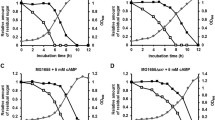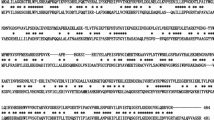Abstract
A spontaneous mutant 9R-4 resistant to 2-deoxyglucose (2DG) was derived from a wild-type strain Pediococcus halophilus I-13. Phosphoenolpyruvate (PEP)-dependent glucose-6-phosphate formation by the permeabilized 9R-4 cells was < 5% of that observed with the parent I-13. In vitro complementation of PEP-dependent 2DG-6-phosphate formation was assayed with combination of the cytoplasmic and membrane fractions prepared from the I-13 and the mutants (9R-4, and X-160 isolated from nature), which were defective in PEP: mannose phosphotransferase system (man:PTS). The defects in man:PTS of both the strain 9R-4 and X-160 were restricted to the membrane fraction (e.g. EIIman), not to the cytoplasmic one. Kinetic studies on the glucose transport with intact cells and iodoacetate-treated cells also supported the presence of two distinct transport systems in this bacterium as follows: (i) The wild-type I-13 possessed a high-affinity man:PTS (K m=11 μM) and a low-affinity proton motive force driven glucose permease (GP) (K m=170 μM). (ii) Both 9R-4 and X-160 had only the low-affinity system (K m=181 μM for 9R-4, 278 μM for X-160). In conclusion, a 2DG-induced selective defect in the membrane component (EIIman) of the man:PTS could partially release glucose-mediated catabolite repression but not frutose-mediated catabolite repression in soy pediococci.
Similar content being viewed by others
Abbreviations
- GCR:
-
glucose-mediated catabolite repression
- FCR:
-
fructose-mediated catabolite repression
- PEP:
-
phosphoenolpyruvate
- man:PTS:
-
phosphoenolpyruvate:mannose phosphotransferase system
- glc:PTS:
-
phosphoenolpyruvate:glucose phosphotransferase system
- GP:
-
glucose permease
- CCCP:
-
carbonylcyanide mchlorophenylhydrazone
- DCCD:
-
N,N′-dicyclohexylcarbodiimide
- ΔP:
-
proton motive force
- G-6-P:
-
glucose-6-phosphate
- 2DG:
-
2-deoxyglucose
- IAA:
-
iodoacetic acid
- EIIman :
-
enzyme II component of man:PTS
- EIIIman :
-
enzyme III component of man:PTS
- EIIglc :
-
enzyme II component of glc:PTS
- EIIIglc :
-
enzyme III component of glc:PTS
References
Abe K, Uchida K (1989) Correlation between depression of catabolite control of xylose metabolism and a defect in the phosphoenolpyruvate:mannose phosphotransferase system in Pediococcus halophilus. J Bacteriol 171:1793–1800
Abe K, Uchida K (1990) Non-PTS uptake and subsequent metabolism of glucose in Pediococcus halophilus as demonstrated with a double mutant defective in phosphoenolpyruvate:mannose phosphotransferase system and in phosphofructokinase. Arch Microbiol 153:537–540
Chassy BM, Thompson J (1983a) Regulation of lactosephosphoenolpyruvate-dependent phosphotransferase system and β-d-phosphogalactosidase galactohydrolase activities in Lactobacillus casei. J Bacteriol 154:1195–1203
Chassy BM, Thompson J (1983 b) Regulation and characterization of the galactose-phosphoenolpyruvate-dependent phosphotransferase system in Lactobacillus casei. J Bacteriol 154: 1204–1214
Hamilton IR, St.Martin EJ (1982) Evidence for the involvement of protonmotive force in the transport of glucose by a mutant Streptococcus mutans strain DR0001 defective in glucosephosphoenolpyruvate phosphotransferase activity. Infect Immun 36:567–575
Keevil CW, McDermid AS, Marsh PD, Ellwood DC (1986) Protonmotive force driven 6-deoxyglucose uptake by the oral pathogen, Streptococcus mutans Ingbritt. Arch Microbiol 146:118–124
Liberman ES, Bleiweis AS (1984) Role of the phosphoenolpyruvate-dependent glucose phosphotransferase system of Streptococcus mutans GS5 in the regulation of lactose uptake. Infect Immun 43:536–542
Postma PW, Roseman S (1976) The bacterial phosphoenolpyruvate:sugar phosphotransferase system. Biochim Biophys Acta 457:213–257
Thompson J, Saier MHJr (1981) Regulation of methyl-β-d-thiogalactoside accumulation in Streptococcus lactis by exclusion and expulsion mechanisms. J Bacteriol 146:885–894
Vadeboncoeur C (1984) Structure and properties of the phosphoenolpyruvate:glucose phosphotransferase system of oral streptococci. Can J Microbiol 30:495–502
Author information
Authors and Affiliations
Rights and permissions
About this article
Cite this article
Abe, K., Uchida, K. Release of glucose-mediated catabolite repression due to a defect in the membrane fraction of phosphoenolpyruvate: mannose phosphotransferase system in Pediococcus halophilus . Arch. Microbiol. 155, 517–520 (1991). https://doi.org/10.1007/BF00245343
Received:
Accepted:
Issue Date:
DOI: https://doi.org/10.1007/BF00245343




